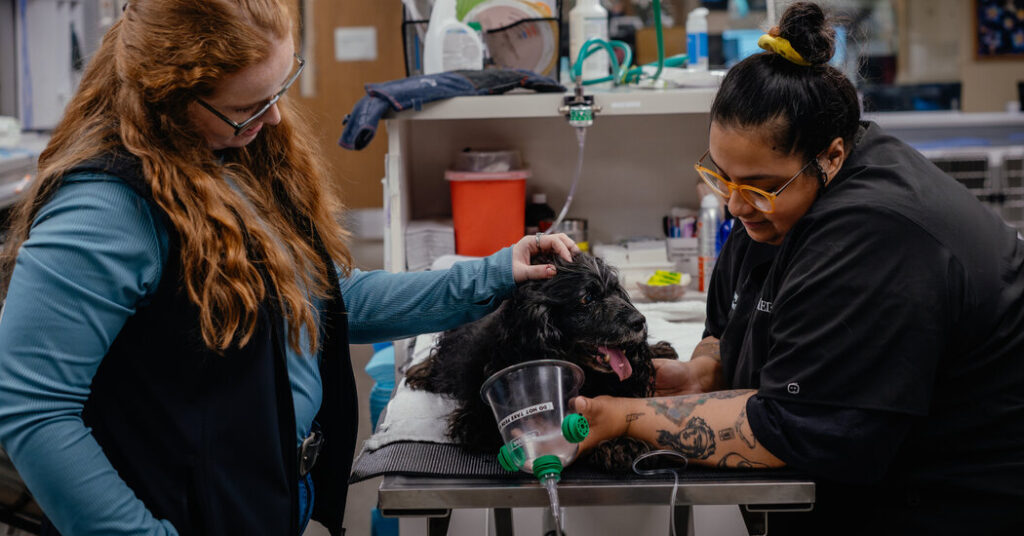Amy Conroy sat alone in a veterinary exam room, hands clutching a water bottle, eyes blinking back tears. Her 16-year-old cat, Leisel, had been having trouble breathing. Now, she was waiting for an update.
The door opened, and Laurie Maxwell came in.
Ms. Maxwell works for MedVet, a 24-hour emergency veterinary hospital in Chicago. But when she took a seat opposite Ms. Conroy on a Monday evening in May, she explained that she wasn’t there for the cat. She was there for Ms. Conroy.
Ms. Maxwell is a veterinary social worker, a job in a little-known corner of the therapy world that focuses on easing the stress, worry and grief that can arise when a pet needs medical care.
Pets no longer exist at the periphery of the human family — to take one example, a survey in 2022 found that almost half of Americans sleep with an animal in their bed. As that relationship has intensified, so has the stress when something goes wrong. Those emotions can spill over at animal hospitals, where social workers can help pet owners work through difficult choices, such as whether to euthanize a pet or whether they can afford to pay thousands of dollars for their care.
Though still rare, social workers in animal hospitals are growing in their ranks. Large chains, like VCA, are beginning to employ them, as are major academic veterinary hospitals. The service is typically offered for free. About 175 people have earned a certification in veterinary social work from the University of Tennessee, Knoxville, which is a center for the field.
Ms. Maxwell, who supervises the work of five social workers at five MedVet locations, also helps out on busy shifts.
In the room with Ms. Conroy, Leisel’s owner, Ms. Maxwell posed one of her go-to questions: “What role does she play in your life?”
Ms. Conroy smiled. “Well, this is terrible to say, because I’ve had other cats,” she said. “But she’s going to be my favorite cat I’ve ever had.”
Ms. Conroy said that when she brought Leisel home from a shelter in 2010, the cat was so fearful that it took two years before Ms. Conroy could even touch her. Now, the two are closely bonded.
“I have social anxiety. And it can be pretty debilitating at times,” Ms. Conroy told Ms. Maxwell. “I kind of feel like she has social anxiety. We share that, you know?”
“Your soul cat,” Ms. Maxwell said. “I think that’s a once-in-a-lifetime cat.”
Down the hall and around the corner, Dani Abboud, a social work student, sat on the floor to speak to Gloria Reyes, her 11-year-old son, Jesreel, and her 8-year-old granddaughter, Janiah. They were visiting Sassy, their 12-year-old pit bull, who was experiencing critical complications from a bladder surgery.
“Where were you earlier?” Ms. Reyes asked Mx. Abboud with a laugh. Hours before, she had struggled to decide whether to euthanize Sassy or to admit her for a second surgery. “If I didn’t see life in her eyes, then maybe,” she said. “I can’t put her down.”
“You know what’s in her heart,” Mx. Abboud said.
The social workers’ main job is to tend to pet owners, but the veterinarians and techs — essentially nurses — say that it helps them, too. “I used to go home and genuinely wonder what happened to a client,” said Dr. Amy Heuberger, the head of MedVet’s Chicago emergency department. Now, she said, “I can take care of more animals in a shift, because I know that the clients are still getting taken care of.”
Elizabeth Strand, the director of the University of Tennessee’s veterinary social work program, said that having a therapist on staff was becoming a selling point for attracting vets and other workers. The industry is a high-stress field, and suicide rates among vets are higher than average.
After leaving Ms. Reyes and the children, Mx. Abboud, who uses they/them pronouns, turned their attention to Evrim Topal, whom they had been helping earlier in the day. Ms. Topal had brought in her family dog, Zorro, a 16-year-old cockapoo, because he was having trouble breathing. An exam revealed that Zorro’s condition was not going to improve.
Mx. Abboud joined Ms. Topal in a “comfort room,” which MedVet reserves for euthanizations. Ms. Topal said her feelings had been in a jumble when she had first arrived. “I don’t think I was prepared to make this decision,” she said. But after talking it through, she felt at peace.
A few moments later, an assistant wheeled Zorro in on a cart. A plastic mask delivered oxygen. She scooped Zorro onto her lap, while Mx. Abboud moved the oxygen tube so he could breathe easier. “Está bien, está bien,” Ms. Topal whispered to Zorro.
After Ms. Topal spent some time alone with Zorro, she rang a bell to let the staff know that she was ready. Dr. Heuberger joined Mx. Abboud in the room.
“Thank you guys for being here,” Ms. Topal said.
Dr. Heuberger knelt on the floor and administered the lethal medications. After a few seconds, Zorro’s breathing stopped.


